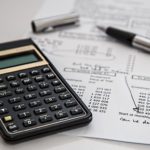
Image by Steve Buissinne from Pixabay
By Mike Whitmire
Depreciation is one of those tasks that bookkeepers and accountants hardly think twice about. Many small business owners have software that calculates depreciation expense for us, so once we post the journal entry, we don’t find ourselves ruminating about depreciation or its larger impact on the business. But maybe it’s time we change that.
What is depreciation?
Managers purchase property, plant, and equipment (PP&E) to help their business produce revenues. Depreciation helps us estimate how much of an asset’s value has been “used up” over time. If estimated correctly, the initial value of the PP&E asset will be recovered through depreciation by the end of its useful life.
Each month, quarter, or year, that asset will be depreciated or expensed. This depreciation will reflect how much of the value has been used by the business during that reporting period.
Accumulated depreciation, which is often listed alongside assets in the chart of accounts, will keep track of the cumulative depreciation expense that has been posted to the income statement. When assets are netted with accumulated depreciation, users of the financial statements can roughly see how much value remains in PP&E.
Why is depreciation important?
Depreciation is important because it helps us decode the true economic impact that assets have on our businesses.
It estimates the cost of doing business
Business profit is determined by subtracting an organization’s expenses from its total revenues. If businesses reported the full costs of assets purchases in the first year, their financial statements would not accurately show how those assets affect business profit over time. Because those assets will help produce revenues over many years, it’s more accurate to spread the costs over time.
It helps show asset value
Depreciation helps businesses better estimate how much value remains in the assets shown on their balance sheets. As the years go by, assets will degrade, and eventually, they must be retired or sold. If the full value of the assets remained on the balance sheet until the asset was retired, users of the financial statements would not have a clear picture of the true economic value those assets held for the business. By reducing the costs of those assets with depreciation expenses (as reflected in the accumulated depreciation account), financial statement users can see those assets’ values over time.
It makes asset values more accurate
Most businesses assume they will use their assets equitably over the life of the asset, which is why the straight-line method of depreciation is most common. In straight-line depreciation, we assume the asset will depreciate the same amount each year until it has zero value (or it reaches its salvage value). For example, if an asset is determined to have a five-year useful life, a straight-line method of depreciation would expense one-fifth of that asset each year.
But businesses don’t have to use the straight-line method of depreciation. They can depreciate assets using a method that best estimates how the asset’s value decreases over time. Consider a car: a better estimate of wear-and-tear may be miles driven rather than the age of the car. The more miles a car is driven, the faster its value decreases. The units of production method of depreciation allow for this type of asset expensing. In this method, the business would assign value to each unit of production (e.g., miles) and the asset would depreciate as those units are produced (e.g., as the car is driven).
Another common depreciation method is the diminishing value method. In this method, the asset loses more of its value in the first few years of use. Computers may be useful for five years according to generally accepted accounting principles (GAAP), but in reality, most of their value is gone in the first one or two years. Each year, as computer technology improves in new machines, the value of your two- or three-year-old computer will drop quickly. This diminishing value method of depreciation can reflect this reality on the books.
GAAP allows businesses to use the depreciation method that most accurately reflects their economic position, making depreciation a tool for improving the accuracy of your financial reports.
It can help lower taxes
Businesses often obsess over depreciation because of its ability to help them lower their tax bill. Depreciation for tax reporting is different than for financial reporting, but the concept is similar. For tax return purposes, the cost of the asset will get recovered as the taxpayer takes depreciation deductions.
The big difference between book and tax depreciation calculations, though, is that the IRS does not care about matching depreciation deductions with the revenues those assets help generate. The IRS has some very generous depreciation deduction allowances that permit many businesses to depreciate assets fully in the year of purchase. Bonus depreciation and Section 179 expensing allow businesses to fully deduct the cost of assets in their year of purchase. Because bonus depreciation and Section 179 expensing is optional, depreciation is one of the most helpful tax planning tools a business can use. Businesses can opt to accelerate depreciation deductions in years they have more taxable income and slow down those deductions in years when they report less income. Doing this can result in the lowest tax bill for your business over time.
Depreciation is one of those accounting requirements that can be easily overlooked, but if you know how to leverage it, the accuracy of your financial reports will rise and you’ll have even stronger information on which to make important business decisions.
_______
Mike Whitmire is co-founder and CEO of FloQast, an accounting close management software company headquartered in Los Angeles. The company works closely with a range of organizations of varying scope and size, helping them to close their books more quickly, efficiently, and accurately.
